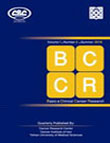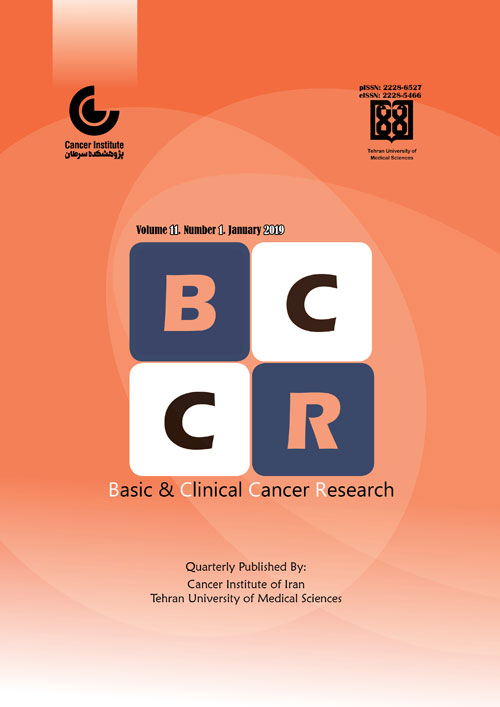فهرست مطالب

Basic and Clinical Cancer Research
Volume:6 Issue: 4, Autumn 2014
- تاریخ انتشار: 1394/04/25
- تعداد عناوین: 7
-
-
New editor: a message from the directorPage 1
-
Page 2IntroductionMigrant studies may provide valuable clues to the etiology of chronic diseases such as cancer. We conducted a migrant study to examine cancer incidence among Iranian immigrants in Sweden.MethodsA cohort of Iranian immigrants in Sweden in 1960-2004 was followed through record linkages with Swedish registers of cancer, death, and migration. We compared Age-Standardized Incidence Rates (ASRs) with corresponding ASRs in Tehran and Sweden and estimated Standard Rate Ratios with 95% confidence intervals (CI). In addition, ASRs were stratified by follow-up time.ResultsIn total 1,041 cancers occurred among 60,718 Iranian immigrants. The ASRs for all cancers combined were 182.3 and 175.5 per 100,000 person-years among men and women, respectively. For men, this rate was slightly and non-significantly higher than in Iran, while for women the excess (24%) was statistically significant. However, their ASRs were significantly lower than those for native Swedes: men had 37% (95% CI 27-47%) and women 35% (95% CI 33-37%) lower ASRs. Compared to male Iranians living in Tehran, ASRs of esophageal and gastric cancer were lower while ASRs of colorectal and prostate cancer were higher, and both of the latter increased with time since immigration. In women, the ASR of non-melanoma skin cancer was lower and that of breast cancer higher and increasing.ConclusionIn male first-generation immigrants, incidence rates of esophageal, gastric, colorectal, and prostate cancer change in the direction of prevailing rates in Sweden, likely due to changes in exposure to environmental risk factors. A similar adjustment occurs for breast and non-melanoma skin cancer among female immigrants.
-
Page 14BackgroundFamily-centered care is an essential concept in cancer but there is no consensus about its meaning and it remains an abstract concept. This study was conducted with the purpose of analyzing the concept of family-centered care in cancer.MethodsConcept analysis of family-centered care was conducted using hybrid model that has 3 phases: theoretical, field work and final analytical phase. For the theoretical phase attributes of family-centered care were identified through a review of the literature (without time limitation). In second phase 6 nurses were interviewed. In third phase final analysis were extracted from the first and second phase.ResultsIn general, original categories in the family-centered care context encompass; existence of family in clinic, family security and family support, communication between nurse and family, family participation in care, exposure to tension and family participation in decision making.ConclusionBy identifying the facilitating and preventive factors about the concept of family care center in cancer, we will be able to run our activities based on scientific findings which could provide the necessary conditions for good implementation of family care center in cancer.Keywords: Cancer, Concept analysis, Family, centered care, Hybrid model
-
Page 21IntroductionIncreasing incidence of cancers, particularly breast cancer (the third cause of death in Iran), the role of information in decision making, policymaking and planning, and the need to assess the status of breast cancer in the country and the world necessitated a research to describe the advantages and disadvantages of the existing information on breast cancer patients. The present study examined the effects of implementing an online management system for breast cancer treatment to resolve the current challenges.Materials And MethodsThis applied study involved preparing the proposal and designing the study protocol, providing the stakeholders with details, obtaining the required approval from the Policymaking Council of the Ministry of Health, designating the secretariat of the center for breast cancer educational management, research, and treatment under the supervision of the Deputy of Research and Technology, software design and production, determination of laboratories where immunohistochemistry-fluorescence in situ hybridization (IHC-FISH) tests were performed, identification of drugstores distributing trastuzumab across the country, and presentation of the final software for integrated online recording of breast cancer information.FindingsLack of integrated information and absence of communication between relevant departments have resulted in inaccurate and untimely (and of course offline) recording of breast cancer information in the country. Launching the designed system and public participation can partly resolve the existing problems.ConclusionOur findings underscored the need for the implementation of an information and treatment management system for breast cancer in Iran. Such a system provides a powerful infrastructure for service provision to all laboratories, drugstores, and specialists who are eager to constantly monitor their patients. It also facilitates data analysis and access to information during decision-making by the managers and experts in different geographical levels.
-
Page 42A 38 years old male worker presented with an advanced left side retroperitoneal mass, with metastatic involvement of 11th Thoracic Vertebra (T11) and resultant paraparesia and paresthesia. The histopathologic examination and immunohistochemical analysis confirmed the diagnosis of paraganglioma. Decompression laminectomy and fixation of involved vertebra resulted to considerable symptomatic relief. Due to unresectability at presentation, chemotherapy with palliative intent performed, and resulted to mild response. Palliative debulking performed after chemotherapy and resulted to better quality of patient's life during next 8 months. Remaining mass at pelvic area increased in size and patient received (131)I-MIBG therapy, 8 months post-operatively. A second debulking surgery, as well as other palliative measures will be considered for future.Keywords: Retroperitoneal paraganglioma, Metastasis, Spinal cord, (131)I, MIBG therapy


